Chevrolet Equinox 2018 Owner's Manual


Contents
Introduction . . . . . . . . . . . . . . . . . . . . . . 2
In Brief . . . . . . . . . . . . . . . . . . . . . . . . . . . 5
Keys, Doors, and Windows . . . . . 31
Seats and Restraints . . . . . . . . . . . 58
Storage . . . . . . . . . . . . . . . . . . . . . . . 108
Instruments and Controls . . . . . . 112
Lighting . . . . . . . . . . . . . . . . . . . . . . . 157
Infotainment System . . . . . . . . . . 165
Climate Controls . . . . . . . . . . . . . . 190
Driving and Operating . . . . . . . . . 198
Vehicle Care . . . . . . . . . . . . . . . . . . 278
Service and Maintenance . . . . . 371
Technical Data . . . . . . . . . . . . . . . . 385
Customer Information . . . . . . . . . 389
Reporting Safety Defects . . . . . . 400
OnStar . . . . . . . . . . . . . . . . . . . . . . . . 403
Index . . . . . . . . . . . . . . . . . . . . 415
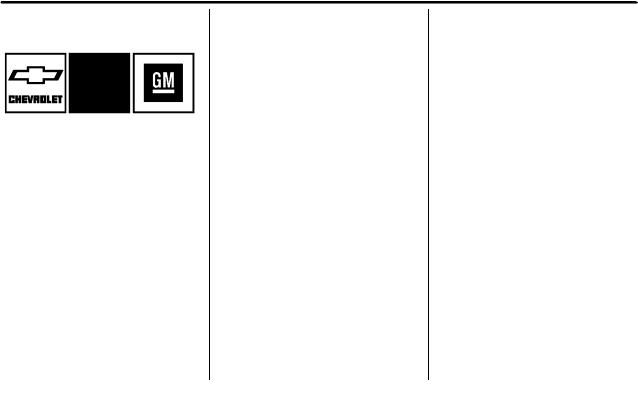
2Introduction
Introduction
The names, logos, emblems, slogans, vehicle model names, and vehicle body designs appearing in this manual including, but not limited to, GM, the GM logo, CHEVROLET, the CHEVROLET Emblem, and EQUINOX are trademarks and/or service marks of General Motors LLC, its subsidiaries, affiliates,
or licensors.
For vehicles first sold in Canada, substitute the name “General Motors of Canada Company” for Chevrolet Motor Division wherever it appears in this manual.
This manual describes features that may or may not be on the vehicle because of optional equipment that was not purchased on the vehicle, model variants, country specifications, features/applications that may not be available in your region, or changes subsequent to the printing of this owner’s manual.
Refer to the purchase documentation relating to your specific vehicle to confirm the features.
Keep this manual in the vehicle for quick reference.
Canadian Vehicle Owners
A French language manual can be obtained from your dealer, at www.helminc.com, or from:
Propriétaires Canadiens
On peut obtenir un exemplaire de ce guide en français auprès du concessionnaire ou à l'adresse suivante:
Helm, Incorporated
Attention: Customer Service
47911 Halyard Drive
Plymouth, MI 48170
USA
Using this Manual
To quickly locate information about the vehicle, use the Index in the back of the manual. It is an alphabetical list of what is in the manual and the page number where it can be found.
Litho in U.S.A. |
© 2017 General Motors LLC. All Rights Reserved. |
Part No. 23143657 D Fourth Printing |
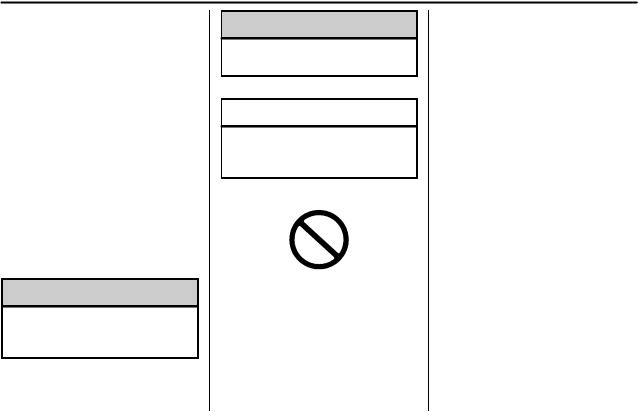
Introduction 3
About Driving the Vehicle
As with other vehicles of this type, failure to operate this vehicle correctly may result in loss of control or an accident. Be sure to read the driving guidelines in this manual in the section called “Driving and Operating” and specifically
Driver Behavior 0 199, Driving Environment 0 199, and Vehicle Design 0 199.
Danger, Warning, and
Caution
Warning messages found on vehicle labels and in this manual describe hazards and what to do to avoid or reduce them.
{Danger
Danger indicates a hazard with a high level of risk which will result in serious injury or death.
{Warning
Warning indicates a hazard that could result in injury or death.
Caution
Caution indicates a hazard that could result in property or vehicle damage.
A circle with a slash through it is a safety symbol which means “Do Not,” “Do not do this,” or “Do not let this happen.”
Symbols
The vehicle has components and labels that use symbols instead of text. Symbols are shown along with the text describing the operation or information relating to a specific component, control, message, gauge, or indicator.
M : Shown when the owner’s manual has additional instructions or information.
* : Shown when the service manual has additional instructions or information.
0 : Shown when there is more information on another page — “see page.”

4Introduction
Vehicle Symbol Chart
Here are some additional symbols that may be found on the vehicle and what they mean. See the features in this manual for information.
9 : Airbag Readiness Light
# : Air Conditioning
! : Antilock Brake System (ABS) $ : Brake System Warning Light
" : Charging System
I : Cruise Control
` : Do Not Puncture
^ : Do Not Service
B : Engine Coolant Temperature
O : Exterior Lamps
_ : Flame/Fire Prohibited
. : Fuel Gauge
+ : Fuses
3 : Headlamp High/Low-Beam Changer
j : ISOFIX/LATCH System Child Restraints
* : Malfunction Indicator Lamp
: : Oil Pressure
O : Power
/ : Remote Vehicle Start
> : Seat Belt Reminders
7 : Tire Pressure Monitor
d : Traction Control/StabiliTrak
a : Under Pressure
M : Windshield Washer Fluid

In Brief |
5 |
In Brief
Instrument Panel
Instrument Panel . . . . . . . . . . . . . . . . 6
Initial Drive Information
Initial Drive Information . . . . . . . . . . 8
Stop/Start System . . . . . . . . . . . . . . . 8
Remote Keyless Entry (RKE)
System . . . . . . . . . . . . . . . . . . . . . . . . 8
Remote Vehicle Start . . . . . . . . . . . 8
Door Locks . . . . . . . . . . . . . . . . . . . . . 9
Liftgate . . . . . . . . . . . . . . . . . . . . . . . . 10
Windows . . . . . . . . . . . . . . . . . . . . . . . 10
Seat Adjustment . . . . . . . . . . . . . . . 11
Memory Features . . . . . . . . . . . . . . 13
Heated and Ventilated Seats . . . 13
Head Restraint Adjustment . . . . 14
Seat Belts . . . . . . . . . . . . . . . . . . . . . 14
Passenger Sensing System . . . 14
Mirror Adjustment . . . . . . . . . . . . . . 15
Steering Wheel Adjustment . . . . 15
Interior Lighting . . . . . . . . . . . . . . . . 16
Exterior Lighting . . . . . . . . . . . . . . . 17
Windshield Wiper/Washer . . . . . . 17
Climate Controls . . . . . . . . . . . . . . . 18
Transmission . . . . . . . . . . . . . . . . . . 19
Vehicle Features
Infotainment System . . . . . . . . . . . 20
Radio(s) . . . . . . . . . . . . . . . . . . . . . . . 20
Satellite Radio . . . . . . . . . . . . . . . . . 21
Portable Audio Devices . . . . . . . . 21
Bluetooth® . . . . . . . . . . . . . . . . . . . . . 21
Steering Wheel Controls . . . . . . . 21
Cruise Control . . . . . . . . . . . . . . . . . 22
Driver Information
Center (DIC) . . . . . . . . . . . . . . . . . 23
Forward Collision Alert (FCA)
System . . . . . . . . . . . . . . . . . . . . . . . 23
Forward Automatic
Braking (FAB) . . . . . . . . . . . . . . . . 23
Lane Keep Assist (LKA) . . . . . . . 23
Lane Change Alert (LCA) . . . . . . 24
Surround Vision . . . . . . . . . . . . . . . 24
Rear Vision Camera (RVC) . . . . 24
Rear Cross Traffic Alert (RCTA)
System . . . . . . . . . . . . . . . . . . . . . . . 24
Parking Assist . . . . . . . . . . . . . . . . . 24
Power Outlets . . . . . . . . . . . . . . . . . 25
Universal Remote System . . . . . 25
Sunroof . . . . . . . . . . . . . . . . . . . . . . . . 25
Performance and Maintenance
Traction Control/Electronic
Stability Control . . . . . . . . . . . . . . 26
Tire Pressure Monitor . . . . . . . . . . 27
Fuel (LYX - 1.5L L4 Turbo
Engine) . . . . . . . . . . . . . . . . . . . . . . . 27 Fuel (LTG - 2.0L L4 Turbo
Engine) . . . . . . . . . . . . . . . . . . . . . . . 28 Fuel (Diesel) . . . . . . . . . . . . . . . . . . . 28 E85 or FlexFuel . . . . . . . . . . . . . . . . 28 Engine Oil Life System . . . . . . . . 28 Driving for Better Fuel
Economy . . . . . . . . . . . . . . . . . . . . . 29 Diesel Particulate Filter . . . . . . . . 29 Diesel Exhaust Fluid . . . . . . . . . . . 30 Roadside Assistance
Program . . . . . . . . . . . . . . . . . . . . . . 30
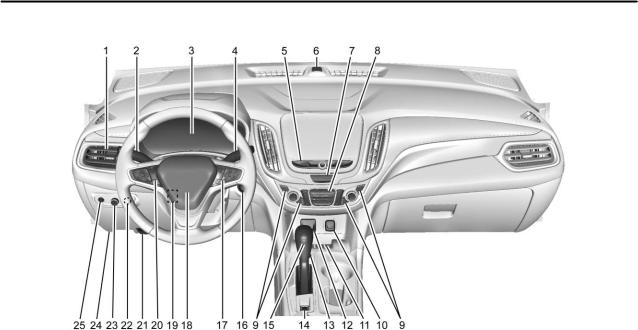
6In Brief
Instrument Panel

In Brief |
7 |
1.Air Vents 0 195.
2.Turn Signal Lever. See Turn and Lane-Change Signals 0 161.
IntelliBeam® System Button (If Equipped). See Exterior Lamp Controls 0 157.
3.Instrument Cluster 0 122.
Driver Information Center (DIC) Display. See Driver Information Center (DIC) 0 139.
4.Windshield Wiper/Washer 0 114.
5.Infotainment 0 165.
6.Light Sensor. See Automatic Headlamp System 0 160.
7.Hazard Warning Flashers 0 160.
8.Climate Control Systems 0 190
(If Equipped).
Dual Automatic Climate Control System 0 192 (If Equipped).
9.Heated and Ventilated Front Seats 0 66 (If Equipped).
10.Power Outlets 0 118.
11.Wireless Charging 0 120 (If Equipped).
12.USB Port 0 173.
Auxiliary Input Jack. See
Auxiliary Devices 0 179.
13.All-Wheel Drive 0 234 (If Equipped).
Tow/Haul Mode 0 234.
14.Electric Parking Brake 0 236.
15.Shift Lever. See Automatic Transmission 0 231.
Manual Mode 0 233.
16.ENGINE START/STOP Button. See Ignition Positions 0 215.
17.Steering Wheel Controls 0 113.
Traction Control/Electronic Stability Control 0 238.
18.Horn 0 114.
19.Steering Wheel Adjustment
0 113 (Out of View).
20.Cruise Control 0 241.
Heated Steering Wheel 0 114
(If Equipped).
Forward Collision Alert (FCA) System 0 248 (If Equipped).
Lane Keep Assist (LKA) 0 254
(If Equipped).
21.Hood Release. See Hood
0 281.
22.Fog Lamps 0 161 (If Equipped).
23.Exterior Lamp Controls 0 157.
24.Data Link Connector (DLC) (Out of View). See Malfunction Indicator Lamp (Check Engine Light) 0 130.
25.Instrument Panel Illumination Control 0 162.

8In Brief
Initial Drive
Information
This section provides a brief overview about some of the important features that may or may not be on your specific vehicle.
For more detailed information, refer to each of the features which can be found later in this owner’s manual.
Stop/Start System
The vehicle may have a fuel saving Stop/Start system to shut off the engine and help conserve fuel.
When the brakes are applied and the vehicle is at a complete stop, the engine may turn off. When the brake pedal is released or the accelerator pedal is pushed, the engine will restart. The engine may restart even while the brake is applied. See Starting the Engine
0 217.
Remote Keyless Entry
(RKE) System
The Remote Keyless Entry (RKE) transmitter may work up to
60 m (197 ft) away from the vehicle.
With Power Liftgate Shown
Press the button to remove the key. The key can be used for all locks.
K : Press to unlock the driver door or all doors depending on vehicle personalization settings.
For vehicles with the manual liftgate, unlocking all doors will also unlock the liftgate.
Q : Press to lock all doors.
Lock and unlock feedback can be personalized. See Vehicle Personalization 0 145.
b : If equipped with the power liftgate, press twice quickly until the liftgate begins to move.
7 : Press and release to initiate vehicle locator. Press and hold for at least three seconds to sound the
panic alarm. Press 7 again to cancel the panic alarm.
/ : Press Q and release and then immediately press and hold / for at least four seconds to start the engine from outside the vehicle. See Remote Vehicle Start 0 38.
See Keys 0 31 and Remote Keyless Entry (RKE) System Operation 0 32.
Remote Vehicle Start
If equipped, the engine can be started from outside of the vehicle.
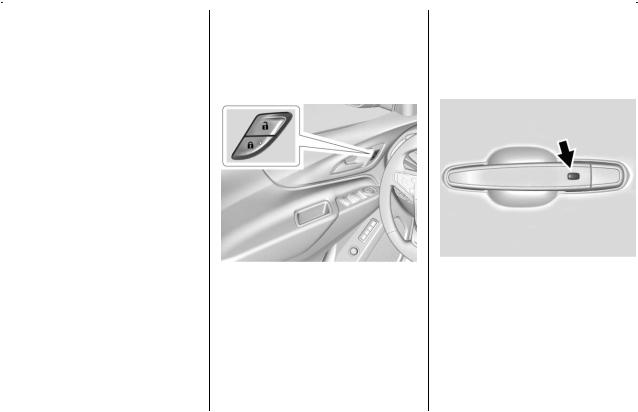
In Brief |
9 |
Starting the Vehicle
1.Press and release Q on the RKE transmitter.
2.Immediately press and hold / for at least four seconds or until the turn signal lamps flash.
Start the vehicle normally after entering.
When the vehicle starts, the parking lamps will turn on.
Remote start can be extended.
Canceling a Remote Start
To cancel a remote start, do one of the following:
.Press and hold / until the parking lamps turn off.
.Turn on the hazard warning flashers.
. Turn the vehicle on and then off.
See Remote Vehicle Start 0 38.
Door Locks
To lock or unlock the vehicle from the outside, press Q or K on the Remote Keyless Entry (RKE) transmitter.
Q : Press to lock the doors. The indicator light in the switch will come on when the door is locked.
K : Press to unlock the doors.
See Door Locks 0 40.
To manually unlock a door from inside the vehicle, pull once on the door handle to unlock it, and a second time to open it.
Keyless Access
Press the button on the driver door handle when the RKE transmitter is within 1 m (3 ft) of the driver door handle. When unlocking from the driver door, the first press unlocks that door; press again within
five seconds to unlock all passenger doors. See Remote Keyless Entry (RKE) System Operation 0 32.

10 In Brief
Liftgate
Manual Liftgate Operation
Unlock the vehicle before opening the liftgate.
To open the liftgate, press the touch pad under the liftgate handle and lift up.
Do not press the touch pad while closing the liftgate. This may cause the liftgate to be unlatched.
Power Liftgate Operation
To operate the power liftgate, the vehicle must be in P (Park). The taillamps flash when the power liftgate moves.
Choose the power liftgate mode by turning the dial on the switch to either the 3/4 or MAX position.
Press 8to open or close the liftgate.
Hands-Free Liftgate
The liftgate will not operate if the RKE transmitter is not within
1 m (3 ft).
To operate, kick your foot straight up in one swift motion under the rear bumper between the left exhaust pipe and the license plate, then pull it back.
See Liftgate 0 44.
Windows
Power windows work when the ignition is on, in ACC/ACCESSORY, or in Retained Accessory Power (RAP). See Retained Accessory Power (RAP) 0 221.
Using the window switch, press to open or pull to close the window.
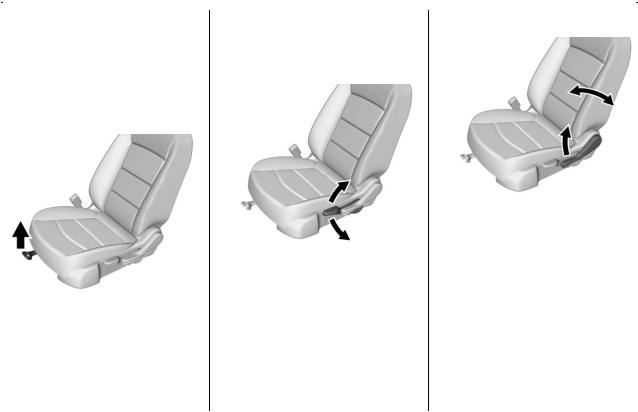
In Brief |
11 |
The windows may be temporarily disabled if they are used repeatedly within a short time.
See Power Windows 0 53.
Seat Adjustment
Manual Front Seats
To adjust a manual seat:
1.Pull the handle at the front of the seat.
2.Slide the seat to the desired position and release the handle.
3.Try to move the seat back and forth to be sure it is locked in place.
Seat Height Adjuster
Move the lever up or down to manually raise or lower the seat.
See Seat Adjustment 0 61.
Reclining Seatbacks
To recline the manual seatback:
1.Lift the lever.
2.Move the seatback to the desired position, then release the lever to lock the seatback in place.
3.Push and pull on the seatback to make sure it is locked.
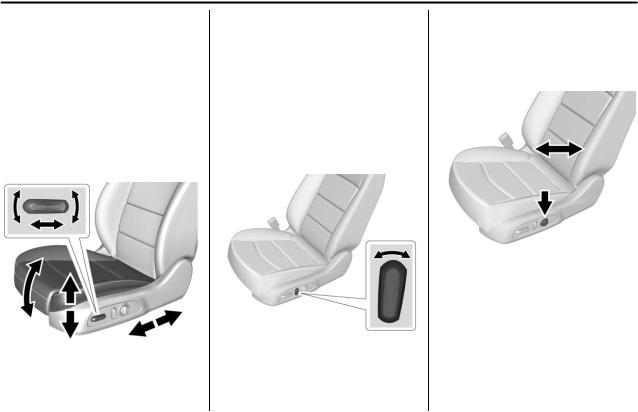
12 In Brief
To return the seatback to an upright position:
1.Lift the lever fully without applying pressure to the seatback, and the seatback returns to the upright position.
2.Push and pull on the seatback to make sure it is locked.
See Reclining Seatbacks 0 62.
Power Driver Seat
To adjust a power driver seat, if equipped:
.Move the seat forward or rearward by sliding the control forward or rearward.
.Raise or lower the front part of the seat cushion by moving the front of the control up or down.
.Raise or lower the entire seat by moving the rear of the control up or down.
See Power Seat Adjustment 0 61.
To recline a power seatback, if equipped:
.Tilt the top of the control rearward to recline.
.Tilt the top of the control forward to raise.
See Reclining Seatbacks 0 62.
Lumbar Adjustment
If equipped, press and hold the front or rear of the control to increase or decrease lumbar support.
See Lumbar Adjustment 0 62.
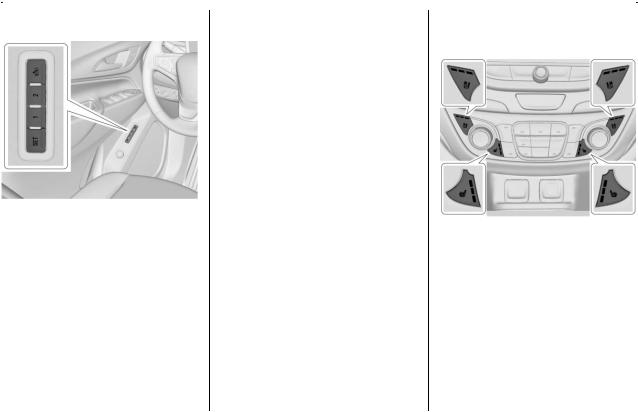
In Brief |
13 |
Memory Features
If equipped, memory seats allow two drivers to store and recall their unique seat positions for driving the vehicle, and a shared exit position for getting out of the vehicle. Other feature positions may also be set, such as power mirrors and power steering wheel, if equipped. Memory positions are linked to RKE transmitter 1 or 2 for automatic memory recalls.
Before storing, adjust all available memory feature positions. Turn the ignition on and then press and release SET; a beep will sound. Then immediately press and hold 1,
2, or B (Exit) on the driver door until two beeps sound. To manually recall these positions, press and
hold 1, 2, or B until the saved position is reached.
When Auto Memory Recall is enabled in vehicle personalization, positions previously stored to memory buttons 1 and 2 are recalled when the ignition is changed from off to on or ACC/ ACCESSORY.
When Easy Exit Options is enabled in vehicle personalization, the feature automatically recalls the previously stored exit position when exiting the vehicle. See Memory Seats 0 63.
Heated and Ventilated
Seats
If available, the buttons are on the climate control panel. To operate, the engine must be running.
To heat the driver or passenger seat cushion and seatback, press L or M. Indicator lights on the button show the current setting.
To ventilate the driver or passenger seat cushion and seatback, press {
or C. Indicator lights on the button show the current setting.

14 In Brief
Press the heated or ventilated button once for the highest setting. With each press of the button, the heated or ventilated seat will change to the next lower setting, and then to the off setting. The lights indicate three for the highest setting and one for the lowest.
See Heated and Ventilated Front
Seats 0 66.
Head Restraint
Adjustment
Do not drive until the head restraints for all occupants are installed and adjusted properly.
To achieve a comfortable seating position, change the seatback recline angle as little as necessary while keeping the seat and the head restraint height in the proper position.
See Head Restraints 0 59 and Seat
Adjustment 0 61.
Seat Belts |
Passenger Sensing |
|
System |
Refer to the following sections for important information on how to use seat belts properly:
.Seat Belts 0 71.
.How to Wear Seat Belts Properly 0 72.
.Lap-Shoulder Belt 0 73.
.Lower Anchors and Tethers for Children (LATCH System) 0 97.
The passenger sensing system turns off the front outboard passenger frontal airbag under certain conditions. No other airbag is affected by the passenger sensing system. See Passenger Sensing System 0 84.
The passenger airbag status indicator will light on the overhead console when the vehicle is started. See Passenger Airbag Status Indicator 0 129.
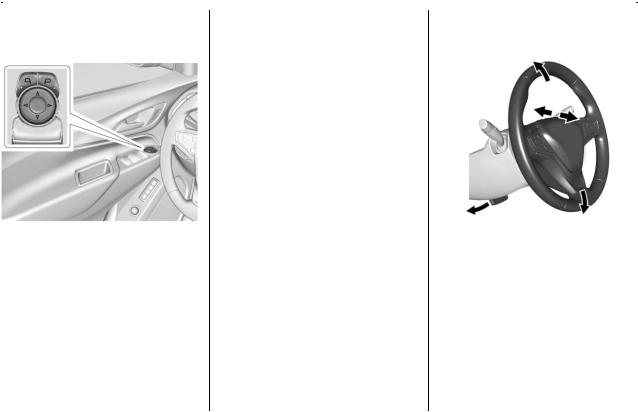
In Brief |
15 |
Mirror Adjustment
Exterior
To adjust the mirrors:
1.Press j or | to choose the driver or passenger mirror.
2.Press the arrows on the control pad to move each mirror in the desired direction.
See Power Mirrors 0 51.
Interior
Adjustment
Adjust the rearview mirror to clearly view the area behind the vehicle.
Manual Rearview Mirror
If equipped, push the tab forward for daytime use and pull it rearward for nighttime use to avoid glare of the headlamps from behind. See
Manual Rearview Mirror 0 52.
Automatic Dimming Rearview
Mirror
If equipped, the mirror will automatically reduce the glare of the headlamps from behind. The dimming feature comes on when the vehicle is started. See Automatic Dimming Rearview Mirror 0 52.
Steering Wheel
Adjustment
To adjust the steering wheel:
1.Pull the lever down.
2.Move the steering wheel up or down.
3.Pull or push the steering wheel closer or away from you.
4.Pull the lever up to lock the steering wheel in place.
Do not adjust the steering wheel while driving.

16 In Brief
Interior Lighting
Dome Lamps
The dome lamp controls are in the overhead console.
To operate, press the following buttons:
jOFF : Press to turn off the dome lamps when a door is open. An indicator light on the button will turn on when the dome lamp
override is activated. Press j OFF again to deactivate this feature
and the indicator light will turn off. The dome lamps will come on when doors are opened.
+ ON/OFF : Press to turn the dome lamps on manually.
Reading Lamps
There are reading lamps on the overhead console and over the rear passenger doors. These lamps come on when any door is opened.
Front Reading Lamps
The front reading lamps are in the overhead console.
Press the lamp lenses to turn the front reading lamps on or off.
Rear Reading Lamps
Press the lamp lens to turn the rear passenger reading lamps on or off.
For more information on interior lighting, see Instrument Panel Illumination Control 0 162.
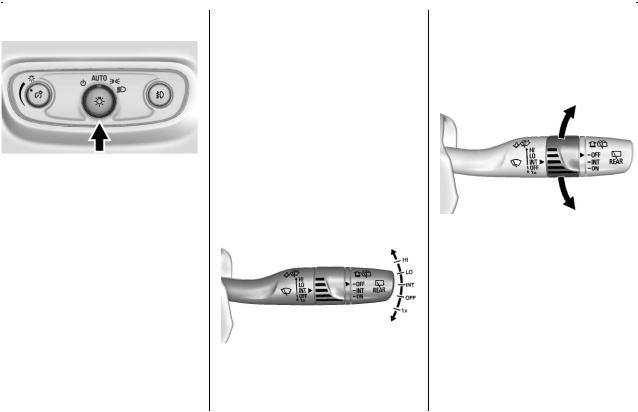
In Brief |
17 |
Exterior Lighting
The exterior lamp control is on the instrument panel to the left of the steering column.
There are four positions.
O : Turns the exterior lamps off and deactivates the AUTO mode. Turn
to O again to reactivate the AUTO mode.
In Canada, the headlamps will automatically reactivate when the vehicle is shifted out of P (Park).
AUTO : Turns the exterior lamps on and off automatically depending on outside lighting.
; : Turns on the parking lamps including all lamps, except the headlamps.
5 : Turns on the headlamps together with the parking lamps and instrument panel lights.
See:
.Exterior Lamp Controls 0 157
.Daytime Running Lamps (DRL) 0 159
.Fog Lamps 0 161
Windshield Wiper/Washer
The windshield wiper/washer lever is on the side of the steering column. With the ignition on or in
ACC/ACCESSORY, move the windshield wiper lever to select the wiper speed.
HI : Use for fast wipes.
LO : Use for slow wipes.
INT : Move the lever up to INT for intermittent wipes, then turn the band up for more frequent wipes or down for less frequent wipes.
OFF : Use to turn the wipers off.
1X : For a single wipe, briefly move the wiper lever down. For several wipes, hold the wiper lever down.
f: Pull the windshield wiper lever toward you to spray windshield washer fluid and activate the wipers.
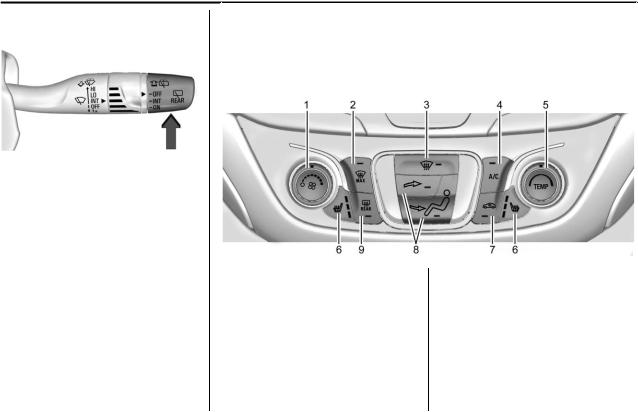
18 In Brief
Rear Window Wiper/Washer
Turn the end of the windshield wiper lever to operate the rear window wiper/washer.
OFF : Turns the system off.
INT : Intermittent wipes.
ON : Slow wipes.
1: Push the windshield wiper lever forward to spray washer fluid on the rear window. The lever automatically returns to its original position when released.
See Windshield Wiper/Washer
0 114 and Rear Window Wiper/
Washer 0 115.
Climate Controls
The vehicle's heating, cooling, defrosting, and ventilation can be controlled with these systems.
Climate Control System
1. |
Fan Control |
6. |
Driver and Passenger Heated |
2. |
MAX Defrost |
|
Seats (If Equipped) |
|
|
||
3. |
Defrost/Defog |
7. |
Recirculation |
|
|
||
4. |
A/C (Air Conditioning) |
8. |
Air Delivery Mode Controls |
|
|
||
5. |
Temperature Control |
9. |
Rear Window Defogger |
|
|

In Brief |
19 |
Dual Automatic Climate Control System
1.Driver and Passenger Temperature Controls
2.MAX Defrost
3.Air Delivery Mode Controls
4.A/C (Air Conditioning)
5.Heated and Ventilated Front Seats (If Equipped)
6.SYNC (Synchronized Temperature)
7.AUTO (Automatic Operation)
8.Fan Control
9. Power
10.Recirculation
11.Rear Window Defogger
See Climate Control Systems 0 190
(If Equipped) or Dual Automatic Climate Control System 0 192 (If Equipped).
Transmission
Electronic Range Select
(ERS) Mode
ERS or manual mode allows for the selection of the range of gear positions. Use this mode when driving downhill to limit the top gear and vehicle speed. See Manual Mode 0 233.
To use this feature:
1.Move the shift lever to L (Manual Mode).
2.Press the plus/minus button on the shift lever, to increase or decrease the gear range available.
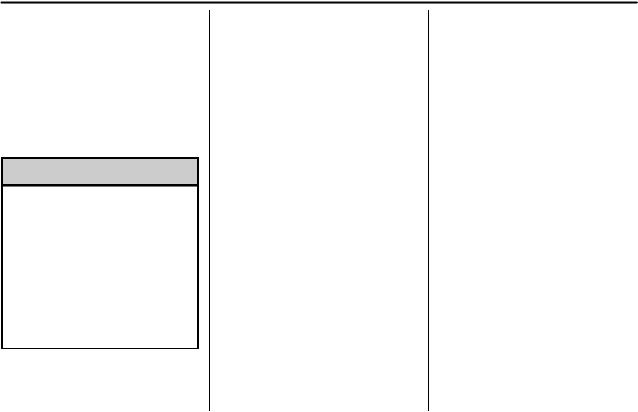
20 In Brief
Vehicle Features
Infotainment System
Base radio information is included in this manual. See the infotainment manual for information on other available infotainment systems.
Read the following pages to become familiar with the features.
{Warning
Taking your eyes off the road for too long or too often while using any infotainment feature can cause a crash. You or others could be injured or killed. Do not give extended attention to infotainment tasks while driving. Limit your glances at the vehicle displays and focus your attention on driving. Use voice commands whenever possible.
The infotainment system has built-in features intended to help avoid distraction by disabling some
functions when driving. These functions may gray out when they are unavailable. Many infotainment features are also available through the instrument cluster and steering wheel controls.
Before driving:
.Become familiar with the operation, center stack controls, and infotainment display controls.
.Set up the audio by presetting favorite stations, setting the tone, and adjusting the speakers.
.Set up phone numbers in advance so they can be called easily by pressing a single control or by using a single voice command if equipped with Bluetooth phone capability.
See Defensive Driving 0 200.
To play the infotainment system with the ignition off, see Retained Accessory Power (RAP) 0 221.
Radio(s)
O :
.Press to turn the power on.
.Press and hold to turn the power off.
.Press to mute/unmute the system when on.
.Turn to decrease or increase the volume.
g :
.Radio: Press and release to fast seek the strongest previous station or channel.
.USB/Music/Pictures: Press to go to the previous content. Press and hold to fast rewind.
d:
.Radio: Press and release to fast seek the next strongest station or channel.
.USB/Music/Pictures: Press to go to the next content. Press and hold to fast forward.
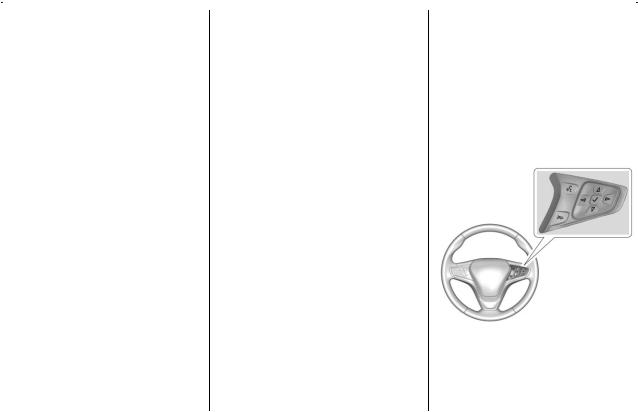
In Brief |
21 |
5 :
.Press and release to access the phone screen, answer an incoming call, or access the device home screen.
See Overview 0 167.
Satellite Radio
If equipped, vehicles with a SiriusXM satellite radio tuner and a valid SiriusXM satellite radio subscription can receive SiriusXM programming.
SiriusXM Satellite Radio
Service
SiriusXM is a satellite radio service based in the 48 contiguous United States and 10 Canadian provinces. SiriusXM satellite radio has a wide variety of programming and commercial-free music, coast to coast, and in digital-quality sound. A fee is required to receive the SiriusXM service.
Refer to:
.www.siriusxm.com or call 1-888-601-6296 (U.S.).
.www.siriusxm.ca or call 1-877-438-9677 (Canada).
See Satellite Radio 0 171.
Portable Audio Devices
This vehicle has a 3.5 mm (1/8 in) auxiliary input and USB ports on the center stack and may have USB ports inside the center console. External devices such as iPods, MP3 players, and USB storage devices may be connected.
See Auxiliary Devices 0 179 and
USB Port 0 173.
Bluetooth®
The Bluetooth system allows users with a Bluetooth-enabled cell phone to make and receive hands-free calls using the vehicle audio system and controls.
The Bluetooth-enabled cell phone must be paired with the in-vehicle Bluetooth system before it can be used in the vehicle. Not all phones will support all functions.
See Bluetooth (Infotainment Controls) 0 181 or Bluetooth (Overview) 0 180.
Steering Wheel Controls
If equipped, some audio controls can be adjusted at the steering wheel.
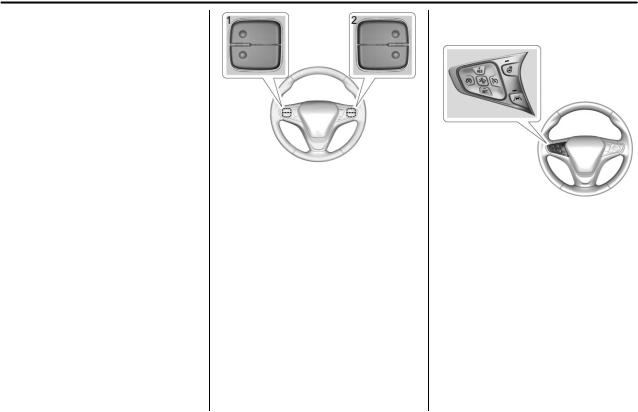
22 In Brief
g : For vehicles with OnStar or a Bluetooth system, press to interact with those systems. See OnStar Overview 0 403 or Bluetooth (Infotainment Controls) 0 181 or Bluetooth (Overview) 0 180.
c : Press to reject an incoming call or end a current call. Press to mute or unmute the infotainment system when not on a call.
o or p : Press to go to the previous or next menu option.
w or x : Press to go to the next or previous selection.
V : Press to select a highlighted menu option.
The favorite and volume switches are on the back of the steering wheel.
1.Favorite: When on a radio source, press to select the next or previous favorite. When on a media source, press to select the next or previous track.
2.Volume: Press to increase or decrease the volume.
Cruise Control
1 : Press to turn the cruise control system on and off. A white indicator comes on in the instrument cluster when cruise is turned on.
* : Press to disengage cruise control without erasing the set speed from memory.
+RES : If there is a set speed in memory, press to resume that speed or press and hold to accelerate. If cruise control is already active, use to increase vehicle speed.
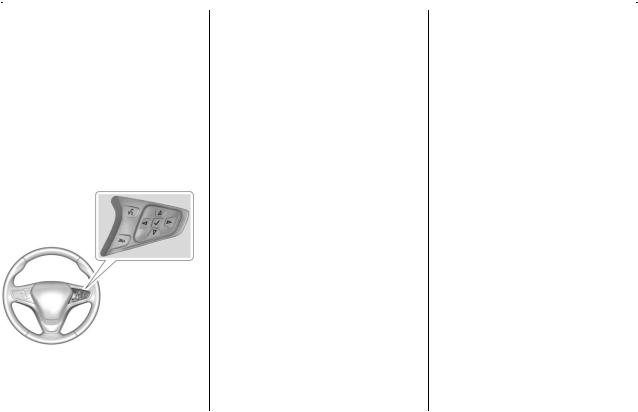
In Brief |
23 |
−SET : Press briefly to set the speed and activate cruise control. If cruise control is already active, use to decrease vehicle speed.
See Cruise Control 0 241.
Driver Information
Center (DIC)
The DIC display is in the instrument cluster. It shows the status of many vehicle systems.
w or x : Press to move up or down in a list.
o or p : Press to move between the interactive display zones in the cluster.
V : Press to open a menu or select a menu item. Press and hold to reset values on certain screens.
See Driver Information Center (DIC) 0 139.
Forward Collision Alert
(FCA) System
If equipped, FCA may help avoid or reduce the harm caused by front-end crashes. FCA provides a
green indicator, V, when a vehicle is detected ahead. This indicator displays amber if you follow a vehicle too closely. When approaching a vehicle ahead too quickly, FCA provides a flashing red alert on the windshield and rapidly beeps or pulses the driver seat.
See Forward Collision Alert (FCA)
System 0 248.
Forward Automatic
Braking (FAB)
If the vehicle has Forward Collision Alert (FCA), it also has FAB, which includes Intelligent Brake
Assist (IBA). When the system detects a vehicle ahead in your path that is traveling in the same direction that you may be about to crash into, it can provide a boost to braking or automatically brake the vehicle. This can help avoid or lessen the severity of crashes when driving in a forward gear.
See Forward Automatic Braking (FAB) 0 250.
Lane Keep Assist (LKA)
If equipped, LKA may help avoid crashes due to unintentional lane departures. It may assist by gently turning the steering wheel if the vehicle approaches a detected lane marking without using a turn signal in that direction. It may also provide a Lane Departure Warning (LDW) alert as the lane marking is crossed. The system will not assist or alert if

24 In Brief
it detects that you are actively steering. Override LKA by turning the steering wheel. LKA uses a camera to detect lane markings between 60 km/h (37 mph) and 180 km/h (112 mph).
See Lane Departure Warning (LDW) 0 254 and Lane Keep Assist (LKA) 0 254.
Lane Change Alert (LCA)
If equipped, the LCA system is a lane-changing aid that assists drivers with avoiding lane change crashes that occur with moving vehicles in the side blind zone (or spot) areas or with vehicles rapidly approaching these areas from behind. The LCA warning display will light up in the corresponding outside mirror and will flash if the turn signal is on. The Side Blind Zone Alert (SBZA) system is included as part of the LCA system.
See Side Blind Zone Alert (SBZA) 0 252 and Lane Change Alert (LCA) 0 252.
Surround Vision
If equipped, views around the vehicle appear in the infotainment display to aid with parking and low-speed maneuvers.
See “Surround Vision” under
Assistance Systems for Parking or Backing 0 245.
Front Vision Camera
If equipped, a view of the area in front of the vehicle appears on the infotainment display to aid with parking and low-speed maneuvers.
See “Front Vision Camera” under
Assistance Systems for Parking or Backing 0 245.
Rear Vision
Camera (RVC)
The RVC displays a view of the area behind the vehicle on the infotainment display when the vehicle is shifted into R (Reverse) to aid with parking and low-speed backing maneuvers.
See Assistance Systems for Parking or Backing 0 245.
Rear Cross Traffic Alert
(RCTA) System
If equipped, the RCTA system shows a triangle with an arrow on the infotainment display to warn of traffic behind your vehicle that may cross your vehicle's path while in R (Reverse). In addition, beeps will sound, or the driver seat will pulse.
See Assistance Systems for Parking or Backing 0 245.
Parking Assist
If equipped, Rear Parking
Assist (RPA) uses sensors on the rear bumper to assist with parking and avoiding objects while in
R (Reverse). It operates at speeds less than 8 km/h (5 mph). RPA may display a warning triangle on the infotainment display and a graphic on the instrument cluster to provide the object distance. In addition, multiple beeps or seat pulses may occur if very close to an object.
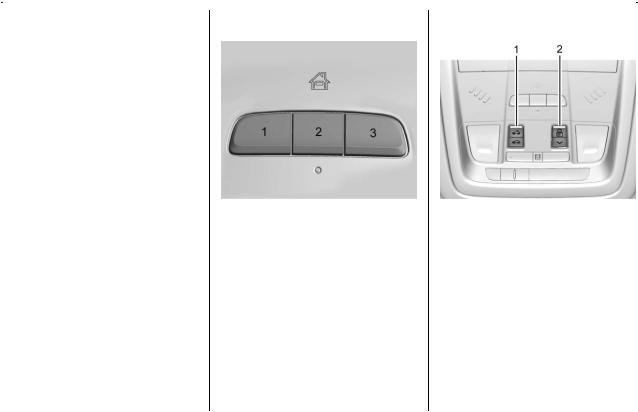
In Brief |
25 |
See Assistance Systems for Parking or Backing 0 245.
Power Outlets
The vehicle has three 12-volt accessory power outlets, which can be used to plug in electrical equipment, such as a cell phone or MP3 player.
There are power outlets:
.On the center stack below the climate control system.
.On the rear of the center floor console.
.In the rear cargo area.
To use the outlet, remove the cover.
See Power Outlets 0 118.
Universal Remote System
If equipped, the Universal Remote System allows for garage door openers, security systems, and home automation devices to be programmed to work with these buttons in the vehicle.
See Universal Remote System 0 154.
Sunroof
1.Sunroof Switch
2.Sunshade Switch
If equipped, the sunroof only operates when the ignition is on or in ACC/ACCESSORY, or when Retained Accessory Power (RAP) is active. See Retained Accessory Power (RAP) 0 221.

26 In Brief
Sunroof Switch
Express-Open/Express-Close : To express-open the sunroof, fully
press and release e(1). Press the switch again to stop it. To express-close the sunroof, fully
press and release g(1). Press the switch again to stop it.
Open/Close (Manual Mode) : To open the sunroof, press and hold e(1) until the sunroof reaches the desired position. Press and hold g(1) to close it.
Comfort Stop : The sunroof has a comfort stop feature that stops the sunroof from opening fully. Press
and release the rear of gto open the sunroof to the comfort open position. Pressing the rear of g again will open the sunroof fully.
If the sunshade is not fully open when the comfort stop feature is pressed the second time, the sunshade will open fully.
Vent : From the closed position, press e(1) to vent the sunroof.
Sunshade Switch
Express-open/Express-close : To express-open the sunshade, fully
press and release r (2). To express-close the sunshade, fully press and release s (2) . Press the switch again to stop it.
Open/Close : To open the sunshade, press and hold r (2) until the sunshade reaches the desired position.
When the sunroof is opened, an air deflector will automatically raise. The air deflector will retract when the sunroof is closed.
Performance and
Maintenance
Traction Control/
Electronic Stability
Control
The Traction Control System (TCS) limits wheel slip. The system is on when the vehicle is started.
The StabiliTrak system assists with directional control of the vehicle in difficult driving conditions. The system is on when the vehicle is started.
TCS and StabiliTrak can be turned off or on using the Driver Information Center (DIC) controls. See Traction Control/Electronic Stability Control 0 238.

In Brief |
27 |
Tire Pressure Monitor
This vehicle may have a Tire Pressure Monitor System (TPMS).
The low tire pressure warning light alerts to a significant loss in pressure of one of the vehicle's tires. If the warning light comes on, stop as soon as possible and inflate the tires to the recommended pressure shown on the Tire and Loading Information label. See
Vehicle Load Limits 0 210. The warning light will remain on until the tire pressure is corrected.
The low tire pressure warning light may come on in cool weather when the vehicle is first started, and then turn off as the vehicle is driven. This may be an early indicator that the tire pressures are getting low and the tires need to be inflated to the proper pressure.
The TPMS does not replace normal monthly tire maintenance. Maintain the correct tire pressures.
See Tire Pressure Monitor System 0 328.
Tire Fill Alert (If Equipped)
This feature provides visual and audible alerts outside the vehicle to help when inflating an underinflated tire to the recommended cold tire pressure. See “Tire Fill Alert (If Equipped)” under Tire Pressure Monitor Operation 0 329.
Fuel (LYX - 1.5L L4 Turbo
Engine)
Regular Fuel
Use only unleaded gasoline rated 87 octane or higher in your vehicle. Do not use gasoline with an octane rating lower as it may result in vehicle damage and lower fuel economy. See Fuel (Gasoline)
0 256.
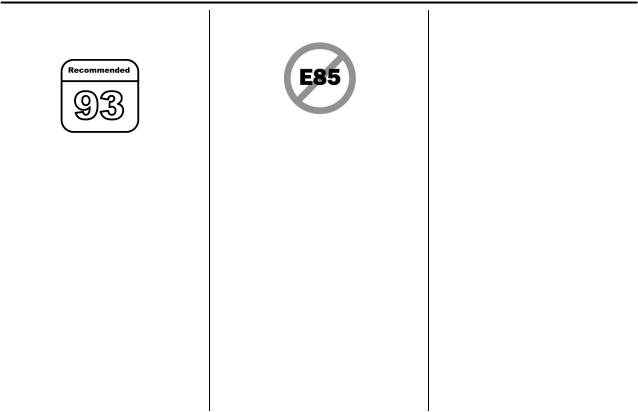
28 In Brief
Fuel (LTG - 2.0L L4 Turbo
Engine)
Premium Recommended Fuel
Use premium 93 octane unleaded gasoline in your vehicle. Unleaded gasoline with an octane rating as low as 87 may be used, but it will reduce performance and fuel economy. See Fuel (Gasoline)
0 256.
Fuel (Diesel)
Use of diesel fuel with ultra low sulfur content (15 ppm, maximum) is required. See Fuel for Diesel Engines 0 258.
E85 or FlexFuel
No E85 or FlexFuel
Gasoline-ethanol fuel blends greater than E15 (15% ethanol by volume), such as E85, cannot be used in this vehicle.
Engine Oil Life System
The engine oil life system calculates engine oil life based on vehicle use and displays the CHANGE ENGINE OIL SOON message when it is time to change the engine oil and filter.
The oil life system should be reset to 100% only following an oil change.
Resetting the Oil Life System
1.Display REMAINING OIL LIFE on the DIC menu. See Driver Information Center (DIC) 0 139.
2.Press and hold V for several seconds while the Oil Life display is active to reset the Oil Life system.
3.REMAINING OIL LIFE 100% will be displayed when the oil life system is successfully reset.
The oil life system can also be reset as follows:
1.Place the ignition in Service Mode. See Ignition Positions 0 215.
2.Display REMAINING OIL LIFE on the DIC menu. See Driver Information Center (DIC) 0 139.
3.Fully press and release the accelerator pedal three times within five seconds.
4.If the display changes to 100%, the system is reset.
See Engine Oil Life System 0 292.

In Brief |
29 |
Driving for Better Fuel Economy
Driving habits can affect fuel mileage. Here are some driving tips to get the best fuel economy possible.
.Avoid fast starts and accelerate smoothly.
.Brake gradually and avoid abrupt stops.
.Avoid idling the engine for long periods of time.
.When road and weather conditions are appropriate, use cruise control.
.Always follow posted speed limits or drive more slowly when conditions require.
.Keep vehicle tires properly inflated.
.Combine several trips into a single trip.
.Replace the vehicle's tires with the same TPC Spec number molded into the tire's sidewall near the size.
.Follow recommended scheduled maintenance.
Diesel Particulate Filter
The engine is equipped with a Diesel Particulate Filter (DPF) that will filter or trap particulates. The DPF is under the vehicle in the exhaust system.
Depending on a number of factors monitored by the engine computer, the DPF will need to be cleaned of accumulated solids. When a cleaning is needed, the engine computer will initiate a cleaning action by warming the exhaust gas temperature. This feature has been designed to operate automatically, with limited operator involvement or awareness.
Cleaning the DPF (Exhaust
Filter)
While the DPF cleaning is automatically controlled by the engine computer, the vehicle will
need to operate continuously for approximately 25 minutes and at speeds greater than
50 km/h (30 mph) to clean the DPF effectively.
Special DPF Driver Messages
If the vehicle is used for numerous short trips or extended slow-speed operation, the engine computer may not be able to clean the DPF effectively. If this happens, a Driver Information Center (DIC) message will display.
If the vehicle continues to be driven in a manner that prevents effective DPF cleaning, the DPF will become plugged. If this occurs, the engine computer will turn on the malfunction indicator lamp in the instrument cluster and a DIC message will display. See Diesel Particulate Filter 0 225, Fuel for Diesel Engines 0 258 and Engine Oil 0 288.
